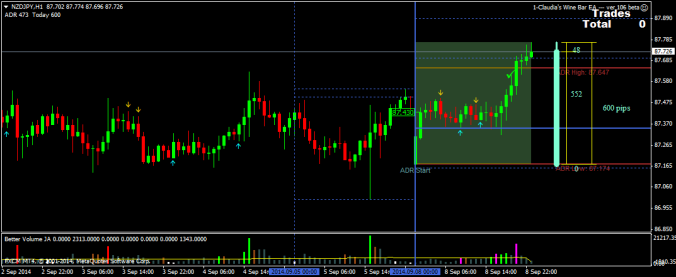Before we get in depth into my methodology, I have to mention that I am using FXCM Oanda as my broker and I trade on MetaTrader 4 platform. I switched from FXCM to Oanda as of October 31st, 2014.
Trading Method #1 – “TNS” Support & Resistance (Manual Swing Trade)
TNS has been my swing trade method for about a year now. This methodology was developed by one of my friend and it is extremely simple to trade with. The idea is that currency move is cyclical and we can look at these previous support and resistance area marked with yellow (support) and grey (resistance) lines to see levels that the current trend is exhausting and we build positions from there. The longer the lines, the more reliable they are. Additionally, you want to read the Daily or Weekly chart as they are less prone to noise.
However, since this is a swing trade methodology, one needs to employ a very strict money management rule lest they will be over-leveraged and might be margin-called. I only risk 2-5% of my capital per pair as well as not exceeding 10-15% of my capital.
Here are my rules of engagement for this swing trade method:
- Use Daily and Weekly charts for less noise and more reliable SR level
- Use starter positions and add over time (i.e. do not enter full position at once as it might move against you)
- Exit position only when it reached either a support or resistance level
- This method works best if you review your position weekly
- Money Management is key since you are not babysitting the trade.
- I only use 2-5% of my capital per pair
Trading Method #2 – Sonic R (Manual Short Term)
Sonic R is my primary manual trading method since Spring 2014. This is a simple 15 minute swing system with Moving Average as well as PVSRA analysis as support.
Having said that, here are my rules of engagement when I am trading this method:
(Note that I will keep adding to this list every time I stumble upon new findings)
- Switch to higher timeframe (Daily, 4 Hours, and 1 Hour) chart.
- Find out if there is any significant candle formation such as pinbars, hammers, or engulfing.
- Do PVSR (Price, Volume, Support, and Resistance) Analysis
- If price is going down, find out whether the purple/red volume is decreasing at low.
- If price is going up, find out whether the blue/green volume is decreasing at high.
- Switch to 15 minutes timeframe for “Classic” entry
- Find a L-H-HL for long entry or H-L-LH for short entry.
- Best if Wave Leg #1 crosses through the “dragon” (EMA formations)
- “Dragon” (EMA formations) should be angled up for long and down for short.
- Price needs to be above the trend for long and below the trend for short
- Find a L-H-HL for long entry or H-L-LH for short entry.
- Trade during London session
- Entry is 5 pips above or below the first candle to break out of “dragon”
- Target price is Historic S&R level
- Stop loss must be 10 pips beyond the extremes of most recent large price swing
- Not more than 100 pips (or 150 pips for more volatile pairs)
Trading Method #3 – Claudia Wine Bar (Automated Short Term)
Currently, I am using the Claudia’s Wine Bar (CWB) as my primary automated trading method. There has been some wonderful discussion on that thread regarding the ins and outs of this EA (Expert Advisor a.k.a ‘bot’). I would like to thank Claudia and Hanover for sharing this methodology for free as well as coding the method into an EA.
CWB is a price action based EA with pivot. When left to run on its own, CWB will take a trade when price crossed over daily pivot and closed either above (long trade) or below (short trade) said level. I tend to trade this manually but the beautiful thing about this EA is that at a click of a button, I can leave my desk and do other things.
Having said that, here are my rules of engagement when I am trading this method:
(Note that I will keep adding to this list every time I stumble upon new findings)
- 1 Hour Chart but do not forget the overall trend. Use higher timeframe to find out.
- GBP/USD pair only (for now).
- Entry level: The close of candle that crosses the pivot which remain above or below daily pivot. In addition to this, the entry level needs to also be at least 3 pips clear from the Daily Pivot in the direction that you’re trading.
- Exit level: Target price or scale out at S/R level. Use trailing stop above the S1/R1 level.
- Target price: 20 pips.
- Stop loss: 15 pips.
- Mind the ADR. If we are trading close to the ADR, it might mean the pair won’t move too much afterwards.
- Do not trade for at least 1 hour after being stopped out.
- Be careful about news releases.
- Watch pivot/support/resistance rejection.
- One (1) open trade at a time.
- “Being on the sidelines” is also a position. Expect some days without trades and that’s okay!



Pingback: Test Day 1 | Nestledrink's Tavern
Pingback: Would You Fancy a Kiwi… Fruit? | Nestledrink's Tavern
Pingback: Spring Cleaning in Australia | Nestledrink's Tavern
Pingback: Spring Sprang Sprung | Nestledrink's Tavern